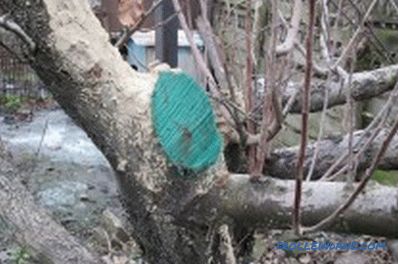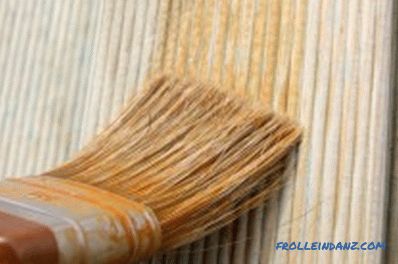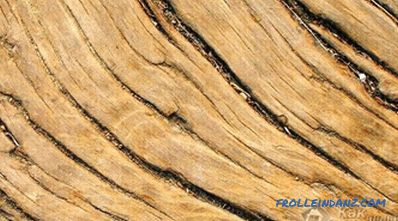Wood today, as before, is considered one of the most durable and environmentally friendly materials, which is widely used in construction and repair work. By virtue of their decorative effect, many people want to trim the surface with it.
Wood is one of the most durable and environmentally friendly materials that is widely used in construction and repair work.
But, as a rule, a tree is considered a living material, therefore it needs mandatory processing that will prevent rotting and damage to the surface. Wood processing from decay today is of two types: folk and synthetic.
Wood processing by folk methods
Let's start with processing by folk remedies. Such methods have a lot of advantages over synthetic formulations. Firstly, such treatment is much cheaper, and secondly, absolutely all folk remedies are ecologically harmless and hypoallergenic in environmental terms, which is very important for human health. Now we will consider in more detail some of the most effective ways of treating wood from rotting:

Copper sulfate treats and disinfects cracks in the root of the branches and the trunk.
- Wood treatment with a mixture of propolis and regular sunflower oil. To do this, take the oil and propolis in a ratio of about 3: 1. Everything is thoroughly mixed and applied to dry wood previously cleaned from dust using a soft sponge. It is necessary with this composition how to soak the wood. The method is good in that it is the strongest in protecting against rot and microorganisms. But there is a big disadvantage in this method. Impregnated wood will ignite very quickly. Therefore, learn this and consider whether it is advisable to use this impregnation in your particular case.
- Impregnation with a solution of copper sulphate. For this purpose, a ready solution of copper sulphate is bought and mixed thoroughly. After that, a soft sponge or a rag is dipped into it, which is used to soak in clean, dry wood. This is an ideal option for a round log, as in material terms it is not too expensive, and its effectiveness is high. With a fairly strong impregnation, the wood will last for a long time without delivering any inconvenience. The only negative is the duration of drying. A tree impregnated in this way must be thoroughly dried in the open air, but that the sun's rays do not fall on it. It is advisable to make a canopy specifically for this purpose. A tree can dry from a week to a month - the longer, the better.
- Another option is to use hot bitumen for processing wood. This is a very good method in terms of efficiency, but in terms of ecology it is not completely safe. After all, as you know, bitumen has the ability to emit some of the harmful substances in the state of heating. Therefore, it is not always recommended to use it.
- Automotive oil also does not belong to completely pure ecological materials, but is widely used for processing wood. Oil perfectly protects from mold, rot and bark beetles, but does not prevent a fire, but makes it even faster and stronger. Therefore, it is not always possible to use this tool.
Finnish treatment

Automotive oil perfectly protects against mildew, rot and bark beetles.
A separate way to process wood is by the Finnish method. It consists in the use of flour, salt, iron sulfate, water, and dry hydrated lime. The method is harmless, but most often it is advisable to use it for processing wood for fences and for roofing. The composition is selected in such a way that it keeps for a long time and is not soon washed away with water.
To prepare the mixture, the components are mixed so that the paste is obtained in the form of sour cream. Moreover, the main part of it consists of water and flour. When you mix everything thoroughly, heat the mixture over low heat and then apply on the wood while still warm in two layers. However, only after complete absorption and drying of the first layer is applied the second.
So, the main folk methods of processing wood from decay are considered. But there are also unnatural synthetic means, which are also widely used. They are also called building antiseptics. It cannot be said that they are all equally harmful or effective. Therefore, it is advisable to understand them in more detail.
Types of water-soluble antiseptics

Antiseptics are best used if the tree has already been rotted.
The first type of wood antiseptics is water-soluble antiseptics. They perfectly protect the tree in conditions of its constant contact with water, but they are also easily washed out. Therefore, periodic treatment of wood by such methods is required. It is accepted to refer to these substances:
- Ammonium and sodium silicium fluoride.These are white, odorless powders that become transparent upon contact with water. Therefore, impregnation with their help should be carried out very carefully, so that the compositions completely penetrate into all the fibers. Ammonium Kremnefluoride, besides protection against fungus, provides the tree with additional fire resistance, which is very important in modern conditions.
- Sodium fluoride is a very strong antiseptic. It is also an odorless white powder. It is easily washed out with water, so the wood processed by this method should undergo such treatments periodically. But such a substance has a big plus: in contrast to the above-mentioned kremneforidov, this substance does not cause corrosion of the metal, which may be in the tree.
- Various imported substances based on mixtures such as zinc, chlorine, sodium, potassium borax and many others. Such mixtures are much more expensive, but to a greater extent protect the tree. But in terms of the environment for residential use is not recommended because they are capable of releasing toxic substances.
Pastes, organic and oil antiseptics
In addition to the antiseptics groups described, it is customary to distinguish between antiseptics in the form of a paste, oil and organic antiseptics. In order to better understand them and select the most appropriate substance, we consider each of these groups in more detail.

Methods for protecting wood from rotting.
- Treating wood from decay with means in the form of pastes. These substances are mixtures of water-soluble antiseptic silicofluorides and binders. Due to this, resistance to moisture is achieved, therefore, pastes are widely used for the treatment of protruding external wooden structures. But even pasta tends to leach out over time. It requires less frequent deposition on wood than fluoride and silicofluoride, but in order to better protect the wood structure, treated with this method, it is recommended to additionally cover with a special building waterproofing film.
- Two main types of solutions are commonly referred to as a water-soluble antiseptic group: these are pentachlorophenol (PL) solutions and copper oil sourcing solutions (NML). Both solutions are light, but have an extremely high degree of toxicity. Antiseptics type NML toxic most. Because of this, working with them requires special care. Moreover, this type of solutions paints a tree green, which can significantly change its appearance. This antiseptic is used only in certain production cases. Substances such as PL are also very toxic. In a way, these are even catalysts of oil antiseptics, which are not able to protect wood in all cases. The use of these solutions is advisable when the wood must be urgently processed. Again, for domestic purposes it is strongly not recommended to use.
- And, finally, another group - oil-type antiseptics. It is customary to include all technical oils. Of course, they also have toxicity. But nevertheless, they, as a rule, possess the best antiseptic properties: they do not wash out with water, protect the wood from almost all types of fungi for a long time, have a strong odor and dark brown color. Treating wood from decaying in this way is impractical in a residential area. But in such structures as piles, supports for bridges, communications pillars and other structures that subsequently will not be in contact with a person and do not need decoration, you can use these antiseptics safely.
So, the main processing options for the tree have been examined and now you know what to process the tree with.
Of course, if possible, it is best to use harmless folk methods that do not carry a toxic hazard.
But in some industries and in open air, you can also use synthetics.
Didn't find the answer in the article? More information on the topic:
-

How to paint a bar correctly
Paint of a bar: features of carrying out external and internal coloring, tools and materials necessary at work. The right choice of paint for glued laminated timber.




